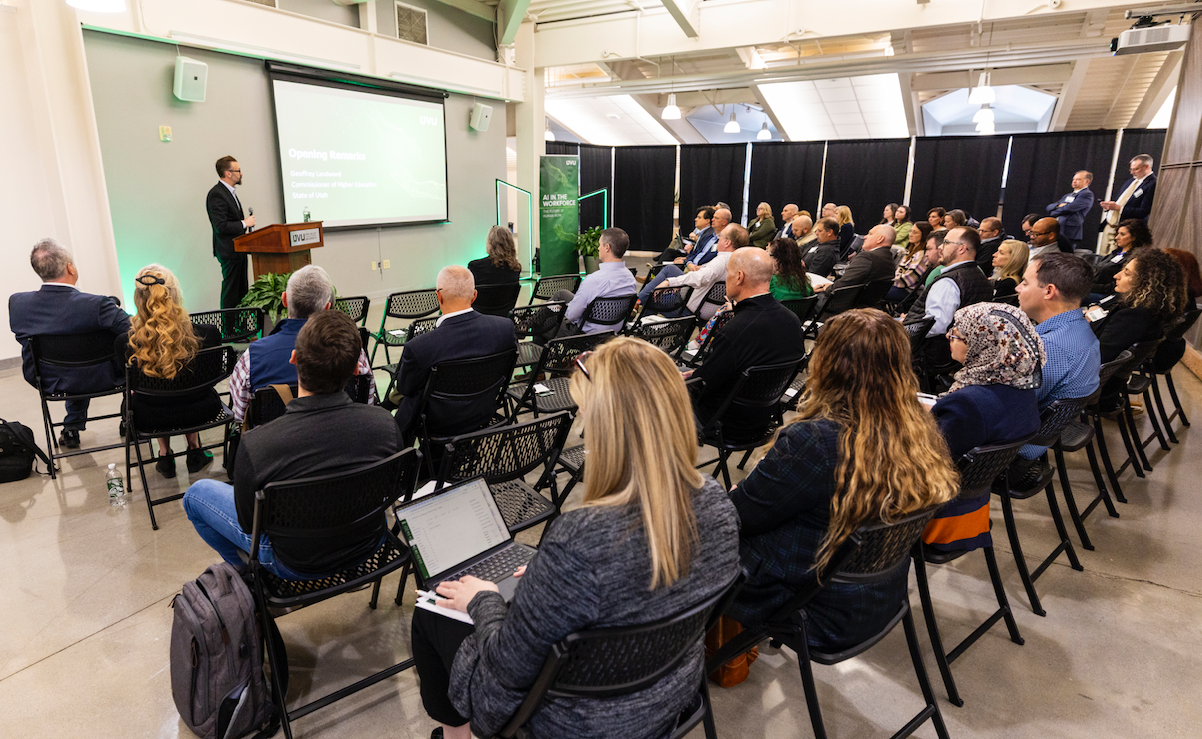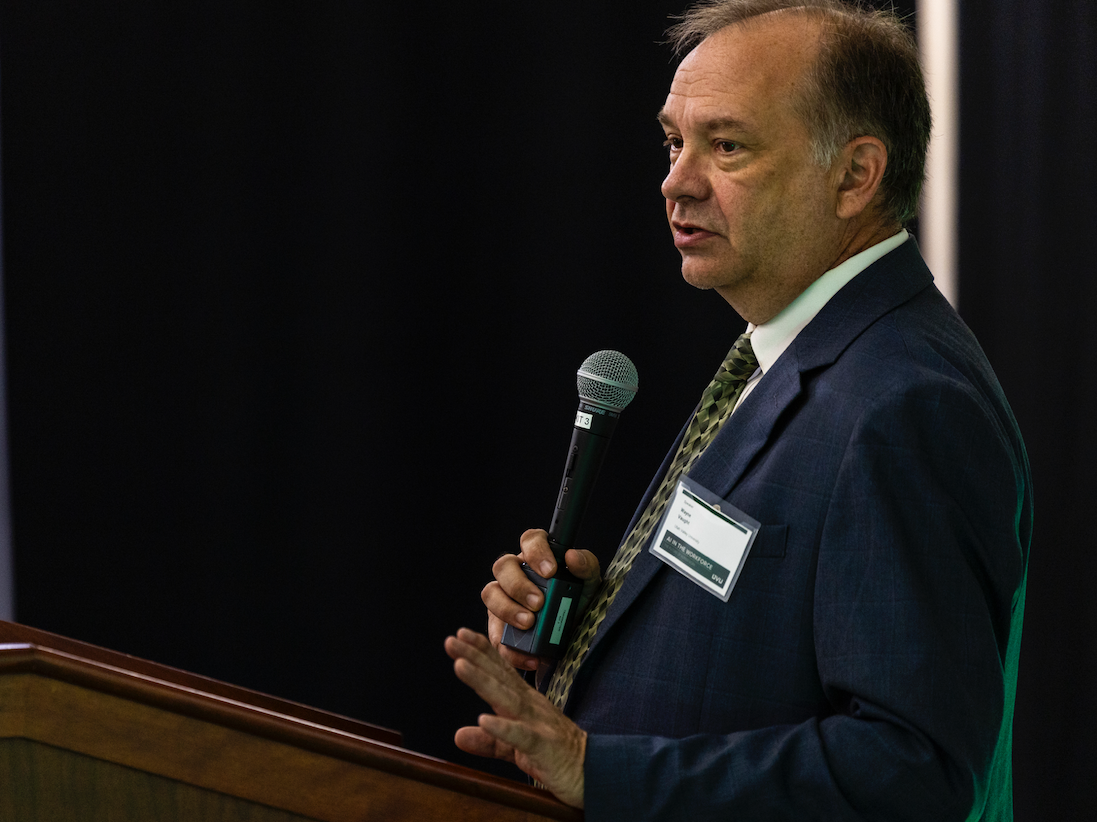

Lehi, Utah — November 10, 2025
As artificial intelligence reshapes industries, universities are grappling with a pressing question: how can higher education equip students with the skills needed to thrive in an AI-driven workforce? Utah Valley University (UVU) tackled this challenge head-on during its AI in the Workforce: The Future of Human Work summit at the Lehi campus on November 7, 2025. The event brought together educators, industry professionals, and local leaders to explore the evolving role of universities in closing the AI talent gap.
Defining Skills for an AI-Integrated Workforce
The conference opened with a clear acknowledgment that AI proficiency is no longer optional. “We’ve seen an 80% increase in job postings listing AI as a required skill,” noted one participant. Yet, the focus was not simply on technical ability, but on how humans interact with AI tools, collaborate, and apply critical thinking.
UVU Provost Dr. Wayne Vaught framed the issue historically and pragmatically. Comparing AI to past technological leaps like the printing press and the internet, he observed that anxiety over new tools is nothing new. “AI will change the workforce, but it won’t replace people,” he said. “Those trained in AI technologies will be the ones with the most impact. Our role as a university is to prepare students—and the broader community—to use these tools effectively.”

Vaught also highlighted the broader role of public universities: not just educating students, but serving as community resources through continuing education and workforce training. These efforts, he noted, ensure both students and local professionals can thrive alongside AI.
Generational Gaps in AI Fluency
A recurring theme was the divide in AI fluency across generations. Younger students, who have grown up interacting with AI for learning and socialization, may struggle with human-to-human communication and resilience. One conference participant observed: “AI never gives anybody pushback. It’s a great mentor, but it tells you exactly what you want to hear. In real life, mentors challenge you. Students growing up in this environment need resilience training to navigate real-world interactions.”
To illustrate the stakes, the group introduced a fictional student, Alex. Comfortable using AI for assignments, communication, and job applications, Alex struggles in a real-world interview with industry professionals. “Alex has all the information but none of the interaction,” a facilitator noted. The case study underscored the need to balance AI integration with mentoring, feedback, and human-centered skills.
Evolving Curriculum and Competencies
Educators discussed how curricula must evolve to prepare students for AI-enabled workplaces. Competencies such as AI literacy, hallucination awareness, and the ability to fail fast were identified as critical. “Integrating AI is not easy,” one professor said. “You need to supervise it. Senior faculty might even be better at catching hallucinations than younger students who tend to trust AI blindly.”

Competency-based assessments and experiential learning were recommended to develop both technical and interpersonal skills. Students must not only learn how to use AI but also how to challenge outputs, collaborate with peers, and navigate human dynamics that machines cannot replicate.
Industry Partnerships as a Talent Pipeline
Conference participants emphasized the importance of bridging academia and industry. Suggestions included AI-integrated coursework tied to real business problems, cross-generational mentorship programs, and sandbox-style partnerships with local companies to simulate applied AI projects. These collaborations help ensure students graduate with skills that are immediately applicable in the workforce while fostering innovation and problem-solving.

The Human-Centered Imperative
UVU Chief AI Officer Dr. Barclay Burns closed the conference with a reminder that, in the AI era, human skills are more important than ever. “In an age of AI, human matters even more so… authenticity is the one thing that we humans are going to take forward into the age of AI,” he said.
Dr. Burns emphasized three types of authenticity—moral, craft, and idiosyncratic—as qualities that machines cannot replicate. He described how educators, managers, and mentors help individuals recognize their unique abilities and life experiences, enabling students to navigate complex professional and personal landscapes. “This kind of human-to-human work… is something machines just don’t do, and I don’t think they will,” he said.

He also highlighted the distinction between knowledge and meaning. Machines can process and generate information rapidly, but humans excel at making sense of their experiences, finding purpose, and validating one another’s stories. As Burns put it: “Our role as educators is shifting from knowledge delivery to helping students make sense of their lives, find purpose, and cultivate uniquely human skills in an AI-driven world.”
Looking Forward
The consensus at the UVU conference was clear: AI will continue to transform workplaces, but the human element remains irreplaceable. Universities must adapt, integrating AI literacy with empathy, communication, creativity, and mentorship. By fostering human-centered skills alongside technical competence, higher education can prepare students to thrive in an environment where AI is a tool, not a replacement.
The event concluded with a shared vision for a future where students are not only technically capable but resilient, adaptable, and authentically themselves. As Vaught and Burns emphasized, the path forward combines workforce readiness with personal growth: teaching students not just to use AI, but to leverage uniquely human qualities that no machine can replicate.
Bridging the AI talent gap is not simply about teaching algorithms or tools. It is about cultivating human authenticity, fostering mentorship, and ensuring that graduates are prepared to meet the challenges of a rapidly evolving workforce. By blending technical literacy with human-centered learning, universities like UVU aim to produce graduates who can collaborate with AI—and with each other—effectively, creatively, and ethically.
Learn more about UVU's AI programs at ms-of-applied-ai.


